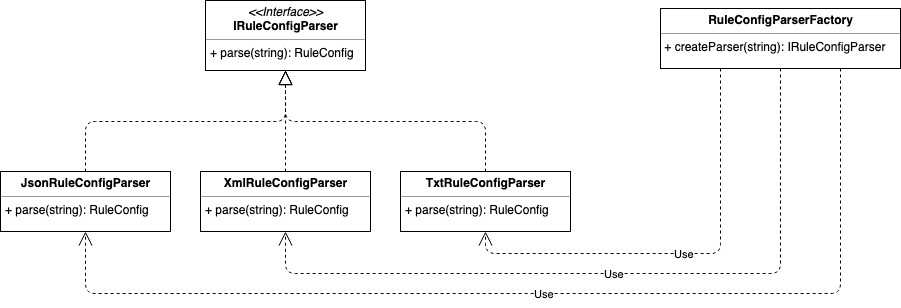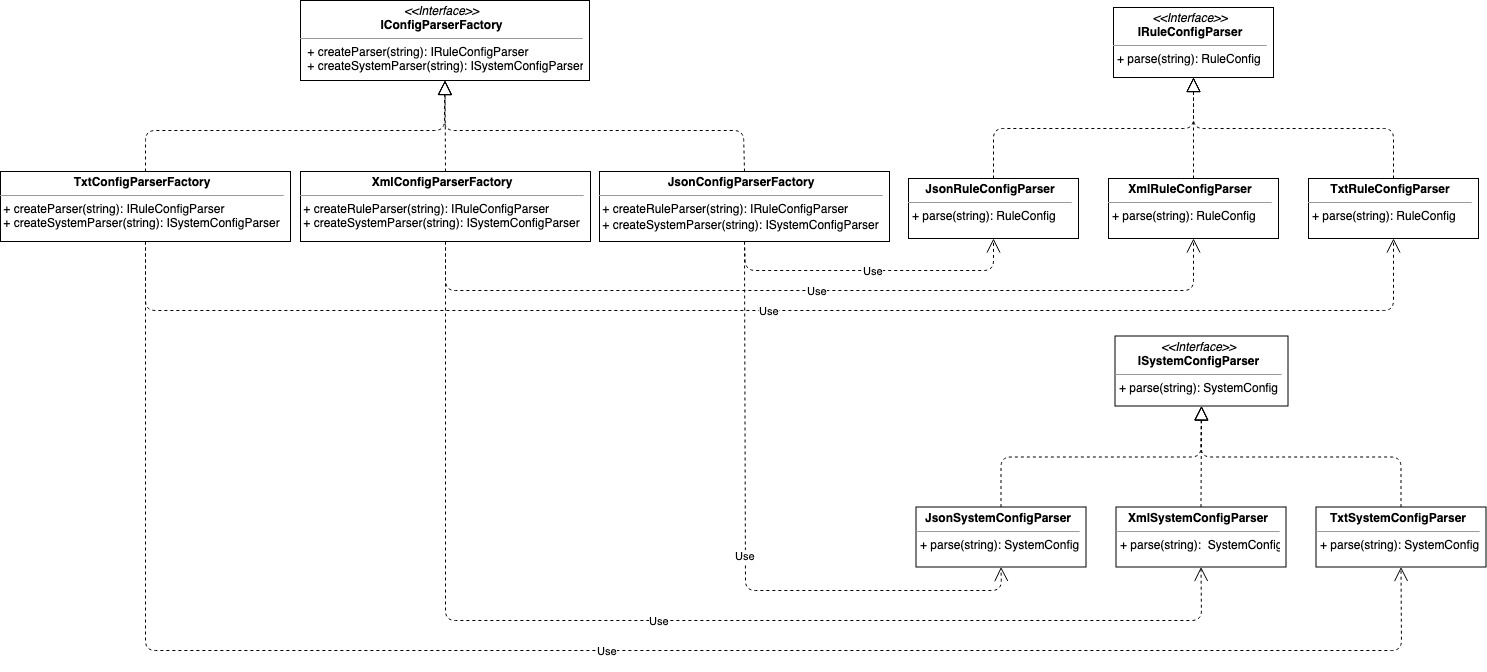Factory Pattern
工厂模式
概念
工厂模式是最常用的设计模式之一,它属于创建型模式,提供了一种创建对象的最佳方式。
一般来说工厂模式分为三种细分类型:简单工厂、工厂方法和抽象工厂,本教程将会就这三个类型逐一讲解。
使用场景
- 单个对象的创建过程比较复杂,如需要结合其他类对象做各种初始化操作等场景;
- 常用在需要动态地根据不同的类型来创建不同的对象,即代码中存在大量的if-else分支判断;
实现方式
简单工厂
概念
定义一个工厂类,根据传入的参数不同返回不同的实例,被创建的实例具有共同的父类或接口;
示例
Java Sample
public class RuleConfigSource {
public RuleConfig load(String path, String fileExtension) {
IRuleConfigParser parser = RuleConfigParserFactory.createParser(fileExtension);
if (parser == null) {
throw new InvalidRuleConfigException("Rule Config file format is not supported:", fileExtension)
}
String configText = "";
RuleConfig ruleConfig = parser.parse(configText);
return ruleConfig;
}
}
public class RuleConfigParserFactory {
public class IRuleConfigParser createParser(String configFormat){
IRuleConfigParser parser = null;
if ("json".equalsIgnoreCase(configFormat)) {
parser = new JsonRuleConfigParser();
} else if ("xml".equalsIgnoreCase(configFormat)) {
parser = new XmlRuleConfigParser();
} else if ("txt".equalsIgnoreCase(configFormat)) {
parser = new TxtRuleConfigParser();
}
return parser;
}
}
Go Sample
// 共同的接口
type IRuleConfigParser interface {
parse(string) RuleConfig
}
// 自定义结构体
type RuleConfig struct{}
// 具体产品角色
type JsonRuleConfigParser struct{}
func (JsonRuleConfigParser) parse(string) RuleConfig { return RuleConfig{} }
type XmlRuleConfigParser struct{}
func (XmlRuleConfigParser) parse(string) RuleConfig { return RuleConfig{} }
type TxtRuleConfigParser struct{}
func (TxtRuleConfigParser) parse(string) RuleConfig { return RuleConfig{} }
// 工厂角色
type RuleConfigParserFactory struct{}
func (RuleConfigParserFactory) createParser(configFormat string) IRuleConfigParser {
var parser IRuleConfigParser
if "json" == strings.ToLower(configFormat) {
parser = new(JsonRuleConfigParser)
} else if "xml" == strings.ToLower(configFormat) {
parser = new(XmlRuleConfigParser)
} else if "txt" == strings.ToLower(configFormat) {
parser = new(TxtRuleConfigParser)
}
return parser
}
func NewRuleConfigParserFactory() RuleConfigParserFactory {
return RuleConfigParserFactory{}
}
// 使用方
type RuleConfigSource struct{}
func (RuleConfigSource) load(path, fileExtension string) RuleConfig {
var ruleConfig RuleConfig
parser := NewRuleConfigParserFactory().createParser(fileExtension)
if parser == nil {
return ruleConfig
}
configText := ""
ruleConfig = parser.parse(configText)
return ruleConfig
}
类图
从上述的Sample中我们可以观察到几个关键对象:抽象产品接口(IRuleConfigParser)、具体产品角色(JsonRuleConfigParser)和工厂角色(RuleConfigParserFactory),它们是简易工厂的重要组成部分,类如如下:

优化改进
另外我们可以发现上述的Sample其实存在优化的空间,我们每次调用RuleConfigParserFactory的createParser时都要创建一个新的parser,实际上parser可以复用,为了节省内存和对象的时间,我们可以先将parser创建然后缓存起来,当调用createParser的时候直接从缓存中取出parser对象使用。
Java Sample
public class RuleConfigParserFactory {
private static final Map<String, RuleConfigParser> cacheParser = new HashMap<>()
static {
cacheParser.put("json", new JsonRuleConfigParser());
cacheParser.put("xml", new XmlRuleConfigParser());
cacheParser.put("txt", new TxtRuleConfigParser());
}
public class IRuleConfigParser createParser(String configFormat){
if (configFormat == null || configFormat.isEmpty()) {
return null;
}
IRuleConfigParser parser = cacheParser.get(configFormat.toLowerCase());
return parser;
}
}
Go Sample
type RuleConfigParserFactory struct {
cacheParser map[string]IRuleConfigParser
}
func (factory RuleConfigParserFactory) createParser(configFormat string) IRuleConfigParser {
if configFormat == "" {
return nil
}
return factory.cacheParser[configFormat]
}
func NewRuleConfigParserFactory() *RuleConfigParserFactory {
factory := new(RuleConfigParserFactory)
factory.cacheParser["json"] = new(JsonRuleConfigParser)
factory.cacheParser["xml"] = new(XmlRuleConfigParser)
factory.cacheParser["txt"] = new(TxtRuleConfigParser)
return factory
}
总结反思
简单工厂的代码实现中,有多出if分支,有违背开发原则,但在没有太多parser或者不需要频繁添加parser的情况下,也是没有太大问题的。
工厂方法
对于上述的例子中,如果我们非得要将if分支逻辑去掉,可以考虑使用工厂方法,利用多态的实现思路进行重构。
概念
定义一个创建对象的接口,但让实现这个接口的类来决定示例实例化哪个类,即工厂方法让类的实例化推迟到子类中进行;
示例
Java Sample
public interface IRuleConfigParserFactory {
IRuleConfigParser createParser();
}
public class JsonRuleConfigParserFactory implements IRuleConfigParserFactory {
@Override
public IRuleConfigParser createParser() {
return new JsonRuleConfigParser();
}
}
public class XmlRuleConfigParserFactory implements IRuleConfigParserFactory {
@Override
public IRuleConfigParser createParser() {
return new XmlRuleConfigParser();
}
}
public class TxtRuleConfigParserFactory implements IRuleConfigParserFactory {
@Override
public IRuleConfigParser createParser() {
return new TxtRuleConfigParser();
}
}
public class RuleConfigParserFactoryMap {
private static final Map<String, IRuleConfigParserFactory> cacheParserFactory = new HashMap<>()
static {
cacheParserFactory.put("json", new JsonRuleConfigParserFactory());
cacheParserFactory.put("xml", new XmlRuleConfigParserFactory());
cacheParserFactory.put("txt", new TxtRuleConfigParserFactory());
}
public class IRuleConfigParserFactory getParserFactory(String type){
if (type == null || type.isEmpty()) {
return null;
}
IRuleConfigParserFactory parserFactory = cacheParserFactory.get(configFormat.toLowerCase());
return parserFactory;
}
}
public class RuleConfigSource {
public RuleConfig load(String path, String fileExtension) {
IRuleConfigParserFactory parserFactory = RuleConfigParserFactoryMap.getParserFactory(fileExtension);
if (parserFactory == null) {
throw new InvalidRuleConfigException("Rule Config file format is not supported:", fileExtension)
}
IRuleConfigParser parser = parserFactory.createParser();
String configText = "";
RuleConfig ruleConfig = parser.parse(configText);
return ruleConfig;
}
}
Go Sample
// 自定义结构体
type RuleConfig struct{}
// 抽象产品接口
type IRuleConfigParser interface {
parse(string) RuleConfig
}
// 抽象工厂接口
type IRuleConfigParserFactory interface {
createParser() IRuleConfigParser
}
// 具体产品角色
type JsonRuleConfigParser struct{}
func (JsonRuleConfigParser) parse(string) RuleConfig { return RuleConfig{} }
// 具体工厂角色
type JsonRuleConfigParserFactory struct{}
func (JsonRuleConfigParserFactory) createParser() IRuleConfigParser {
return new(JsonRuleConfigParser)
}
type XmlRuleConfigParser struct{}
func (XmlRuleConfigParser) parse(string) RuleConfig { return RuleConfig{} }
type XmlRuleConfigParserFactory struct{}
func (XmlRuleConfigParserFactory) createParser() IRuleConfigParser {
return new(XmlRuleConfigParser)
}
type TxtRuleConfigParser struct{}
func (TxtRuleConfigParser) parse(string) RuleConfig { return RuleConfig{} }
type TxtRuleConfigParserFactory struct{}
func (TxtRuleConfigParserFactory) createParser() IRuleConfigParser {
return new(TxtRuleConfigParser)
}
type RuleConfigParserFactory struct {
cacheParserFactory map[string]IRuleConfigParserFactory
}
func NewRuleConfigParserFactory() *RuleConfigParserFactory {
factory := new(RuleConfigParserFactory)
factory.cacheParserFactory["json"] = new(JsonRuleConfigParserFactory)
factory.cacheParserFactory["xml"] = new(XmlRuleConfigParserFactory)
factory.cacheParserFactory["txt"] = new(TxtRuleConfigParserFactory)
return factory
}
type RuleConfigSource struct{}
func (RuleConfigSource) load(path, fileExtension string) RuleConfig {
var ruleConfig RuleConfig
parserFactory := NewRuleConfigParserFactory().cacheParserFactory[fileExtension]
if parserFactory == nil {
return ruleConfig
}
parser := parserFactory.createParser()
configText := ""
ruleConfig = parser.parse(configText)
return ruleConfig
}
类图
从上述的Sample中我们可以观察四个关键对象:抽象产品接口(IRuleConfigParser)、具体产品角色(JsonRuleConfigParser)、抽象工厂接口(IRuleConfigParserFactory)、具体工厂角色(JsonRuleConfigParserFactory)

总结反思
从上述的例子中我们可以总结出工厂方法使用过程中的一些优缺点:
- 优点:当我们需要添加新的角色时只需要创建新的parser类和parser factory类,并且在RuleConfigParserFactoryMap类中将新的parser factory对象添加到cache对象中即可,代码改动较少,基本符合开闭原则;
- 缺点:工厂模式需要额外创建诸多的Factory类,增加代码的复杂性,且此处的每个工厂类只是做简单的创建工作,功能单薄,也显得多余;
抽象工厂
它的应用场景比较特殊,没有前面两种常用,主要是提供一个超级工厂来创建其他工厂;
在上面的例子中,类只有一种分类方式,即RuleConfigParser,但如果假设我们即要求按照RuleConfig配置又要按照System配置来分类时,那我们的工厂数量就会成倍增加,这个时候我们可以考虑让一个工厂创建多个不同类型(即RuleConfig和System)的对象。
示例
Java Sample
public interface IConfigParserFactory {
IRuleConfigParser createRuleParser();
ISystemConfigParser createSystemParser();
}
public class JsonConfigParserFactory implements IConfigParserFactory {
@Override
public IRuleConfigParser createRuleParser() {
return new JsonRuleConfigParser();
}
public ISystemConfigParser createSystemParser() {
return new JsonSystemConfigParser();
}
}
public class XmlConfigParserFactory implements IConfigParserFactory {
@Override
public IRuleConfigParser createRuleParser() {
return new XmlRuleConfigParser();
}
public ISystemConfigParser createSystemParser() {
return new XmlSystemConfigParser();
}
}
public class TxtConfigParserFactory implements IConfigParserFactory {
@Override
public IRuleConfigParser createRuleParser() {
return new TxtRuleConfigParser();
}
public ISystemConfigParser createSystemParser() {
return new TxtSystemConfigParser();
}
}
public class ConfigParserFactoryMap {
private static final Map<String, IConfigParserFactory> cacheParserFactory = new HashMap<>()
static {
cacheParserFactory.put("json", new JsonConfigParserFactory());
cacheParserFactory.put("xml", new XmlConfigParserFactory());
cacheParserFactory.put("txt", new TxtConfigParserFactory());
}
public class IConfigParserFactory getConfigParserFactory(String type){
if (type == null || type.isEmpty()) {
return null;
}
IRuleConfigParserFactory parserFactory = cacheParserFactory.get(configFormat.toLowerCase());
return parserFactory;
}
}
public class RuleConfigSource {
public RuleConfig load(String path, String fileExtension) {
IConfigParserFactory parserFactory = RuleConfigParserFactoryMap.getParserFactory(fileExtension);
if (parserFactory == null) {
throw new InvalidRuleConfigException("Rule Config file format is not supported:", fileExtension)
}
IRuleConfigParser parser = parserFactory.createRuleParser();
String configText = "";
RuleConfig ruleConfig = parser.parse(configText);
return ruleConfig;
}
}
Go Sample
// 自定义结构体
type RuleConfig struct{}
type SystemConfig struct{}
// 抽象工厂接口
type IConfigParserFactory interface {
createRuleParser() IRuleConfigParser
createSystemParser() ISystemConfigParser
}
// 抽象产品接口
type IRuleConfigParser interface {
parse(string) RuleConfig
}
type ISystemConfigParser interface {
parse(string) SystemConfig
}
// 具体工厂角色
type JsonConfigParserFactory struct{}
func (JsonConfigParserFactory) createRuleParser() IRuleConfigParser {
return new(JsonRuleConfigParser)
}
func (JsonConfigParserFactory) createSystemParser() ISystemConfigParser {
return new(JsonSystemConfigParser)
}
// 具体产品角色
type JsonRuleConfigParser struct{}
func (JsonRuleConfigParser) parse(string) RuleConfig { return RuleConfig{} }
type JsonSystemConfigParser struct{}
func (JsonSystemConfigParser) parse(string) SystemConfig { return SystemConfig{} }
type XmlConfigParserFactory struct{}
func (XmlConfigParserFactory) createRuleParser() IRuleConfigParser {
return new(XmlRuleConfigParser)
}
func (XmlConfigParserFactory) createSystemParser() ISystemConfigParser {
return new(XmlSystemConfigParser)
}
type XmlRuleConfigParser struct{}
func (XmlRuleConfigParser) parse(string) RuleConfig { return RuleConfig{} }
type XmlSystemConfigParser struct{}
func (XmlSystemConfigParser) parse(string) SystemConfig { return SystemConfig{} }
type TxtConfigParserFactory struct{}
func (TxtConfigParserFactory) createRuleParser() IRuleConfigParser {
return new(TxtRuleConfigParser)
}
func (TxtConfigParserFactory) createSystemParser() ISystemConfigParser {
return new(TxtSystemConfigParser)
}
// 具体产品角色
type TxtRuleConfigParser struct{}
func (TxtRuleConfigParser) parse(string) RuleConfig { return RuleConfig{} }
type TxtSystemConfigParser struct{}
func (TxtSystemConfigParser) parse(string) SystemConfig { return SystemConfig{} }
type RuleConfigParserFactory struct {
cacheParserFactory map[string]IConfigParserFactory
}
func NewRuleConfigParserFactory() *RuleConfigParserFactory {
factory := new(RuleConfigParserFactory)
factory.cacheParserFactory["json"] = new(JsonConfigParserFactory)
factory.cacheParserFactory["xml"] = new(XmlConfigParserFactory)
factory.cacheParserFactory["txt"] = new(TxtConfigParserFactory)
return factory
}
type RuleConfigSource struct{}
func (RuleConfigSource) load(path, fileExtension string) RuleConfig {
parserFactory := NewRuleConfigParserFactory().cacheParserFactory[fileExtension]
var ruleConfig RuleConfig
if parserFactory == nil {
return ruleConfig
}
parser := parserFactory.createRuleParser()
configText := ""
ruleConfig = parser.parse(configText)
return ruleConfig
}
类图

总结反思
- 如果存在多个对象且每个对象的创建逻辑都比较简单时推荐使用简单共产模式,将多个对象的创建逻辑放入一个工厂类中;
- 如果每个对象的创建逻辑都比较复杂,推荐使用工厂方法模式以避免设计出过于庞大的简单工厂类;
- 如果创建对象的逻辑不复杂,可以考虑通过直接new来创建对象,不需要工厂模式;


